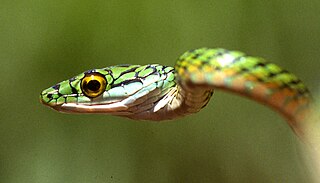
Leptophis ahaetulla, commonly known as the lora or parrot snake, is a species of medium-sized slender snake of the family Colubridae. It is endemic to Central America and northern South America.

Ahaetulla nasuta, also known as Sri Lankan green vine snake and long-nosed whip snake, is a venomous, slender green tree snake endemic to Sri Lanka.
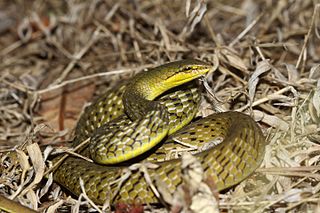
Ahaetulla perroteti, known commonly as the bronze-headed vine snake, Perrotet's vine snake, or the Western Ghats bronzeback, is a species of mildly venomous, rear-fanged snake in the family Colubridae. The species is endemic to the Western Ghats in South India.

Ahaetulla prasina is a species of snake in the family Colubridae to southern Asia. Its common names include Asian vine snake, Boie's whip snake, Gunther's whip snake, Oriental whip snake,.

Brown-speckled whipsnake or brown vine snake is a species of tree snake endemic to Sri Lanka. Populations in the Western Ghats of India are now considered a separate species, Ahaetulla sahyadrensis. It is known as හෙනකදයා (henakadaya) in Sinhala; this name provided the name anaconda.
Dendrelaphis biloreatus is a species of tree snake in the family Colubridae. The species is endemic to Asia.
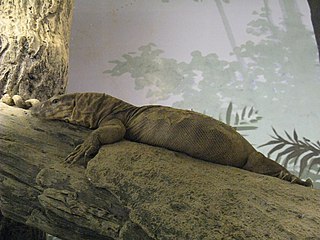
The yellow monitor or golden monitor is a monitor lizard native to South Asia.

Ahaetulla, commonly referred to as Asian vine snakes or Asian whip snakes, is a genus of colubrid snakes distributed throughout tropical Asia. They are considered by some scientists to be mildly venomous and are what is commonly termed as 'rear-fanged' or more appropriately, opisthoglyphous, meaning their enlarged teeth or fangs, intended to aid in venom delivery, are located in the back of the upper jaw, instead of in the front as they are in vipers or cobras. As colubrids, Ahaetulla do not possess a true venom gland or a sophisticated venom delivery system. The Duvernoy's gland of this genus, homologous to the venom gland of true venomous snakes, produces a secretion which, though not well studied, is considered not to be medically significant to humans.

The Angolan slender mongoose is a mongoose native to southwestern Africa, specifically southwestern Angola and northwestern Namibia. It has been listed as "Least Concern" on the IUCN Red List, as it is not threatened and thought to be common. It has a long, slim body and there are different colour forms, a black or dark brown form in the southern part of its range, and a yellowish- or reddish-brown form in the north. This mongoose inhabits dry, rocky habitats and feeds on insects, scorpions and small vertebrates.
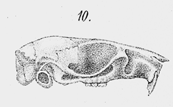
Oligoryzomys flavescens, also known as the flavescent colilargo or yellow pygmy rice rat is a species of rodent in the genus Oligoryzomys of family Cricetidae. It is found in southern South America, occurring in southern Brazil, Paraguay, Uruguay, and northeastern Argentina. Its karyotype has 2n = 64-66 and FNa = 66-70.
The yellow serotine is a species of vesper bat. It is found in Angola, Burundi, Cameroon, Malawi, and Mozambique. Its natural habitats are subtropical or tropical forests and savanna.

The greater red musk shrew is a species of mammal in the family Soricidae. It is found in Lesotho, Mozambique, South Africa, and Eswatini. Its natural habitats are moist savanna, temperate grassland, and rural gardens. Like most shrew species, C. flavenscens is nocturnal. The greater red musk shrew is considered to be asocial and territorial, with males using scent marking to establish their territory. Males appear to be more aggressive than females, and their aggression increases with greater population density.
Green snake or Greensnake or Green Snake may refer to:

Ahaetulla mycterizans, the Malayan green whipsnake or Malayan vine snake, is a slender arboreal snake found in Western Peninsular Malaysia, Java and Sumatra of Indonesia, Singapore, Thailand and possibly Laos up to elevation of 350 m.

The speckle-headed whipsnake is a species of snake of the family Colubridae.
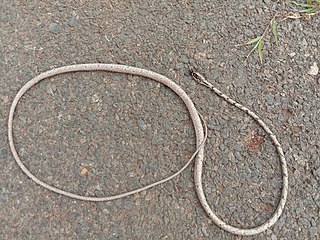
The variable colored vine snake is a species of snake in the family Colubridae. It is the first reported sexually dichromatic snake from the Indian Subcontinent, and until 2017 was formerly regarded as a subspecies of the green vine snake, Ahaetulla nasuta.

The Ahaetuliinae are a subfamily of the snake family Colubridae that was erected in 2016 and comprises five genera containing 63 species that are more closely related to one another than to members of the subfamily Colubrinae. Previously placed within Colubrinae, Ahaetuliinae was strongly supported as the sister group to Colubrinae in a 2016 study by Figueroa et al.

Proahaetulla is a monotypic genus of snake in the family Colubridae. It contains only one species, the keeled vine snake, which is endemic to the Western Ghats of India. Its natural habitat is montane rainforests of southern Western Ghats.

Ahaetulla sahyadrensis is a species of tree snake endemic to the Western Ghats of India. It is also reported from Bangladesh.
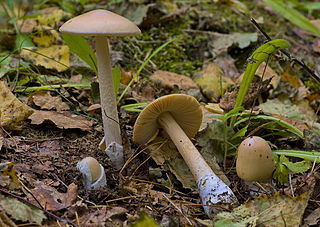
Amanita flavescens is a species of Amanita found in Sweden and Norway.















